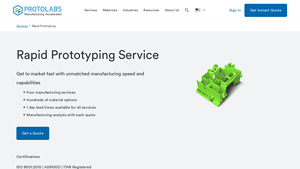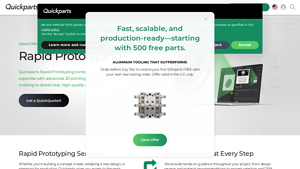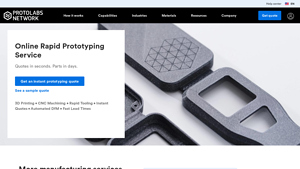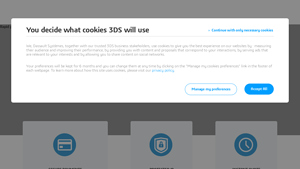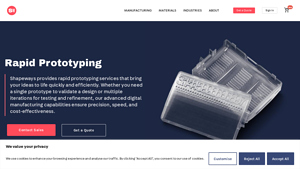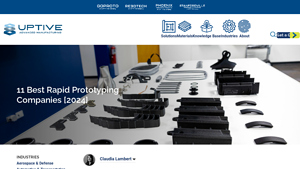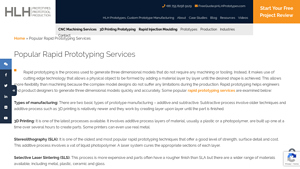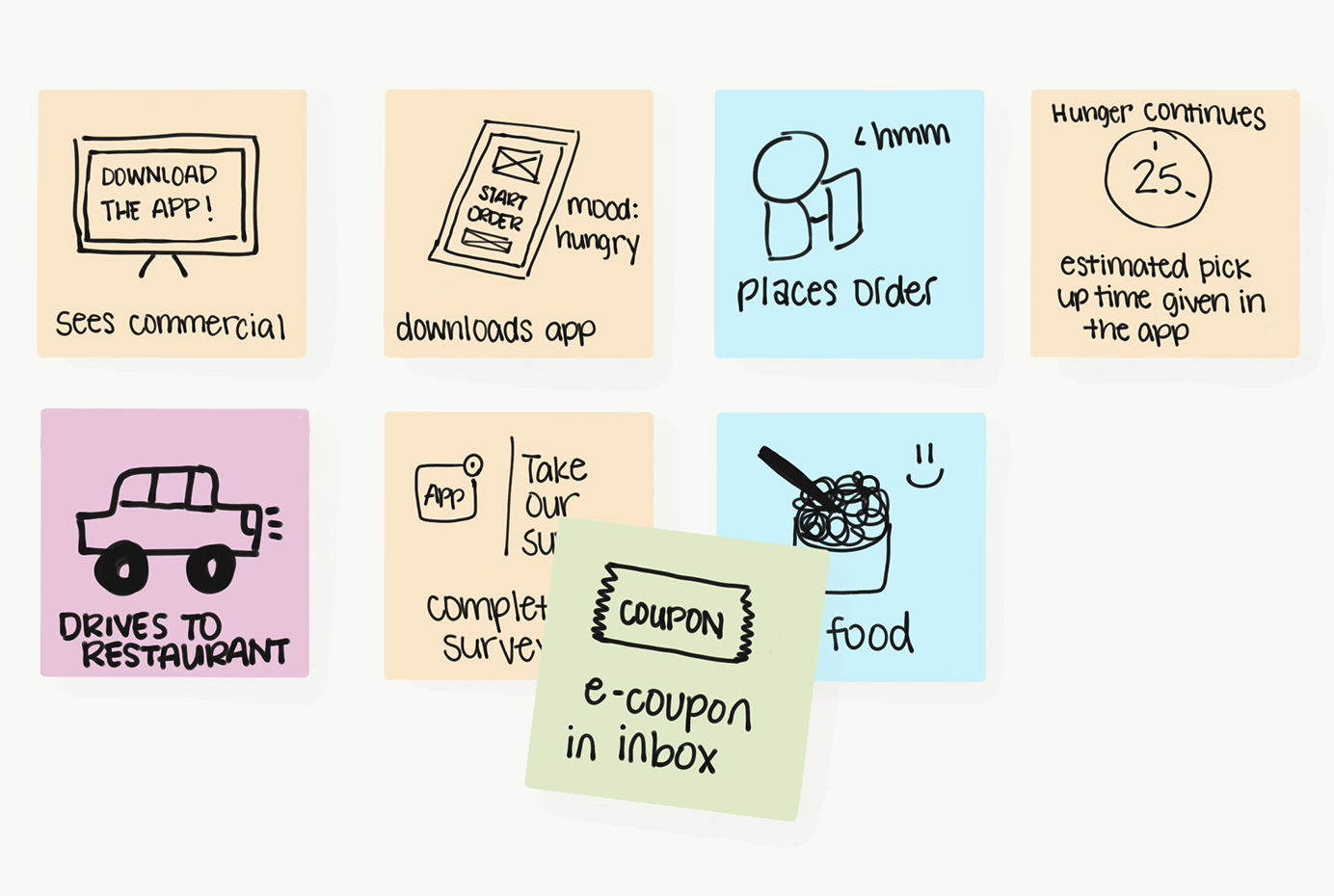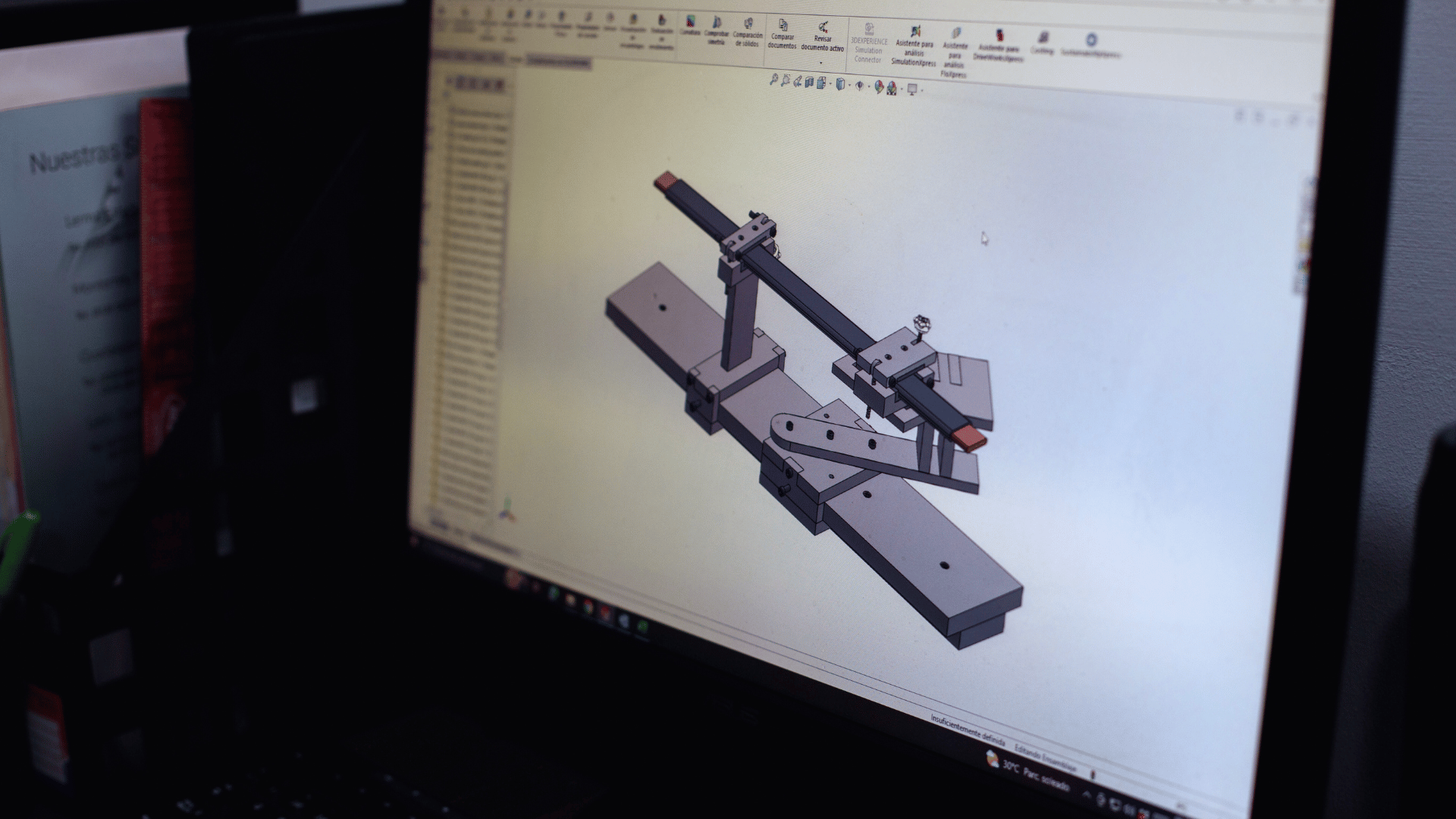Top 7 Fast Prototyping Service List and Guide
Top 7 Fast Prototyping Service Manufacturers & Suppliers List
1. Protolabs – Rapid Prototyping Services
Domain: protolabs.com
Registered: 2006 (19 years)
Introduction: Rapid Prototyping Service offers unmatched manufacturing speed and capabilities with four manufacturing services: 3D Printing, CNC Machining, Injection Molding, and Sheet Metal Fabrication. Key features include:
– Hundreds of material options available across services.
– 1-day lead times for all services.
– Manufacturing analysis included with each quote.
– Certifications: ISO 9001:2015, AS910…
2. Quickparts – Rapid Prototyping Services
Domain: quickparts.com
Registered: 1997 (28 years)
Introduction: Quickparts offers expert rapid prototyping services combining over 35 years of manufacturing expertise with advanced technologies such as 3D printing, CNC machining, and rapid injection molding. Key services include:
1. **3D Printing**: Supports complex geometries and fine details for concept models and functional prototypes, with a variety of materials and resolutions available.
2. **Rapid Injec…
3. Hubs – Rapid Prototyping Service
Domain: hubs.com
Registered: 1998 (27 years)
Introduction: Rapid Prototyping Service offers instant quotes and online ordering for on-demand custom manufacturing. Key features include:
– **3D Printing Technologies**: Fused Deposition Modeling (FDM), Stereolithography (SLA), Selective Laser Sintering (SLS), Multi Jet Fusion (MJF).
– **CNC Machining**: Includes CNC milling and CNC turning.
– **Additional Services**: Sheet metal fabrication and injection mo…
4. Dassault Systèmes – Rapid Prototyping Services
Domain: 3ds.com
Registered: 1995 (30 years)
Introduction: Rapid Prototyping Service by Dassault Systèmes 3DEXPERIENCE Make offers online rapid prototyping services for engineers needing quick and cost-effective product design iterations. Key features include: instant quotes for 3D printing and CNC machining, secure payments, protected IP with confidentiality options, and a large network of over 130 industrial rapid prototyping service providers primarily…
5. Shapeways – Rapid Prototyping Services
Domain: shapeways.com
Registered: 2008 (17 years)
Introduction: Shapeways offers rapid prototyping services that enable fast and efficient production of prototypes for design validation and testing. Key features include:
– Precision prototyping for unique, single-unit prototypes.
– Scalable prototyping for iterative development, allowing adjustments based on test results.
– Extensive material options including plastics and metals, categorized by manufacturing …
6. UPTIVE – Key Manufacturing Services
Domain: uptivemfg.com
Registered: 2023 (2 years)
Introduction: Key product details include: 1. UPTIVE Advanced Manufacturing – Services: Rapid prototyping, Additive manufacturing, CNC machining, Sheet metal fabrication, Injection molding and tooling, Post-processing and finishing. Technologies: Direct Metal Laser Sintering (DMLS), Selective Laser Sintering (SLS), Fused Deposition Modeling (FDM), Stereolithography (SLA), HP Multi Jet Fusion (MJF), Polyjet (PJP…
7. HLH Prototypes – Rapid Prototyping Services
Domain: hlhprototypes.com
Registered: 2012 (13 years)
Introduction: Rapid Prototyping Services include: 1. 3D Printing – Additive process using materials like plastic or photopolymer, can also use metal. 2. Stereolithography (SLA) – Popular technique offering strength and surface detail, uses liquid photopolymer cured by laser. 3. Selective Laser Sintering (SLS) – More expensive, wider material range including metal, plastic, ceramic, and glass, but rougher finish…
Introduction: Navigating the Global Market for fast prototyping service
In today’s fast-paced global economy, sourcing fast prototyping services can be a pivotal challenge for businesses aiming to accelerate product development and maintain a competitive edge. Rapid prototyping not only facilitates quick iterations of design concepts but also enables companies to gather critical feedback before committing to large-scale production. This comprehensive guide delves into various types of fast prototyping services, including 3D printing, CNC machining, and injection molding, while also exploring their specific applications across different industries.
With a focus on the unique needs of international B2B buyers from regions such as Africa, South America, the Middle East, and Europe—including key markets like Brazil and Saudi Arabia—this guide equips decision-makers with the insights necessary for informed purchasing. It outlines essential factors for vetting suppliers, understanding cost implications, and optimizing the selection of materials and processes tailored to diverse project requirements. By addressing these critical areas, the guide empowers businesses to navigate the complexities of the global prototyping landscape, ensuring that they can effectively meet their design goals while minimizing risks and costs. As your partner in this journey, we aim to demystify the prototyping process, providing you with the tools to make strategic decisions that drive innovation and success.
Understanding fast prototyping service Types and Variations
| Type Name | Key Distinguishing Features | Primary B2B Applications | Brief Pros & Cons for Buyers |
|---|---|---|---|
| 3D Printing | Utilizes additive manufacturing; quick turnaround; versatile materials | Concept modeling, functional testing, small batch production | Pros: Fast, cost-effective, complex geometries. Cons: Limited material properties for some applications. |
| CNC Machining | High precision; suitable for final material evaluation; longer lead times | Mechanical testing, low-volume production, functional prototypes | Pros: High accuracy, diverse materials. Cons: Longer setup time, potentially higher costs. |
| Injection Molding | Produces high-quality parts; effective for low-volume runs | Production validation, pilot runs, market feedback | Pros: Excellent surface finish, scalable. Cons: Higher initial costs for tooling. |
| Sheet Metal Fabrication | Rapid production of flat parts; cost-effective for metal prototypes | Enclosures, brackets, and structural components | Pros: Quick turnaround, good material selection. Cons: Limited to flat geometries, setup time required. |
| Jigs & Fixtures | 3D printed tooling; minimizes errors; tailored to specific applications | Assembly line tooling, production aids | Pros: Reduces production errors, custom solutions. Cons: May require design iterations for optimal use. |
What Are the Characteristics and Suitability of 3D Printing for Fast Prototyping?
3D printing is a cornerstone of rapid prototyping, leveraging additive manufacturing to create parts from CAD files. It is particularly suitable for projects requiring quick iterations, such as concept models or functional prototypes. With a range of materials available, including plastics and metals, 3D printing allows for complex geometries that traditional manufacturing methods cannot achieve. Buyers should consider the specific material properties required for their prototypes, as some applications may not benefit from the limitations of certain 3D printed materials.
How Does CNC Machining Support Precision in Prototyping?
CNC machining stands out for its precision and capability to produce parts from a variety of materials, including metals and plastics. This method is ideal for prototypes that need to be evaluated in their final form, as it provides high accuracy and can accommodate tight tolerances. However, the lead time is generally longer due to machine setup and run times. B2B buyers should weigh the importance of precision against the urgency of their project timelines when considering CNC machining.
What Are the Advantages of Injection Molding in Rapid Prototyping?
Injection molding is a highly effective method for producing high-quality prototypes and low-volume production runs. This process allows for the creation of parts that closely mimic final production quality, making it suitable for functional validation and pilot production. While the initial costs for tooling can be significant, the benefits include excellent surface finishes and the ability to scale up production quickly. Buyers should assess their budget and the necessity for high-quality finishes when opting for injection molding.
Why Choose Sheet Metal Fabrication for Rapid Prototyping?
Sheet metal fabrication is ideal for creating flat parts quickly, making it a cost-effective choice for prototypes that require evaluation in their final material. Common applications include enclosures and structural components. While the turnaround time is comparable to CNC machining, the method is limited to flat geometries and requires additional setup time. B2B buyers should consider their design requirements and production timelines when selecting sheet metal fabrication as their prototyping method.
How Do Jigs and Fixtures Enhance Production Efficiency?
Jigs and fixtures are essential tools in the prototyping process, particularly when 3D printed to reduce errors in assembly and production. These tools are custom-designed based on specific applications, allowing for enhanced efficiency and accuracy on the production line. While they can significantly minimize production errors, buyers should be prepared for potential design iterations to ensure optimal performance. Understanding the specific assembly processes can guide businesses in selecting the right jigs and fixtures for their needs.
Key Industrial Applications of fast prototyping service
| Industry/Sector | Specific Application of fast prototyping service | Value/Benefit for the Business | Key Sourcing Considerations for this Application |
|---|---|---|---|
| Aerospace | Development of lightweight components | Accelerates design validation and reduces material costs | Ensure compliance with aviation regulations and certifications |
| Automotive | Prototype parts for new vehicle models | Speeds up market introduction and enhances design flexibility | Source materials that meet safety and performance standards |
| Medical Devices | Creation of surgical instruments and implants | Facilitates rapid testing and regulatory approval processes | Prioritize biocompatibility and adherence to medical regulations |
| Consumer Electronics | Design iterations for gadgets and devices | Improves user experience and reduces time-to-market | Consider scalability for mass production and cost-effectiveness |
| Industrial Equipment | Custom tooling and fixtures | Increases manufacturing efficiency and reduces production downtime | Evaluate precision capabilities and material options available |
How is Fast Prototyping Used in Aerospace Development?
In the aerospace sector, fast prototyping services are essential for developing lightweight components that meet stringent performance criteria. By utilizing advanced 3D printing and CNC machining, aerospace companies can create prototypes that undergo rigorous testing and validation, ensuring they meet both safety and regulatory standards. This rapid iteration process enables engineers to explore innovative designs without the prohibitive costs typically associated with traditional manufacturing methods. For international buyers, it’s crucial to verify the supplier’s compliance with aerospace certifications and quality assurance processes to mitigate risks.
What Role Does Fast Prototyping Play in the Automotive Industry?
The automotive industry leverages fast prototyping services to develop and test prototype parts for new vehicle models. This capability allows manufacturers to accelerate their design cycles, enabling them to bring vehicles to market more quickly while refining features based on real-world testing. With the increasing complexity of automotive systems, rapid prototyping facilitates design flexibility, allowing teams to iterate on components efficiently. Buyers from regions like Brazil and Saudi Arabia should focus on suppliers who can deliver both high-quality prototypes and materials that comply with local automotive safety regulations.
How is Fast Prototyping Beneficial for Medical Device Development?
In the medical devices sector, fast prototyping services are critical for creating surgical instruments and implants that require precise design and functionality. Rapid prototyping allows for quick iterations and testing of prototypes, significantly speeding up the regulatory approval process. This is especially important in a field where time-to-market can directly impact patient outcomes. International buyers must ensure that the materials used are biocompatible and that the prototypes meet relevant medical device regulations, which may vary by country.
How Does Fast Prototyping Enhance Consumer Electronics Design?
Fast prototyping services are invaluable in the consumer electronics industry, where rapid design iterations can significantly improve user experience. Companies can quickly create prototypes of gadgets and devices, allowing for user testing and feedback before mass production. This process not only reduces the risk of costly design flaws but also enables manufacturers to stay competitive in a fast-paced market. Buyers in Europe and South America should consider suppliers that offer scalable solutions, ensuring that successful prototypes can be transitioned into cost-effective mass production.
What Advantages Does Fast Prototyping Offer in Industrial Equipment Manufacturing?
In the industrial equipment sector, fast prototyping services facilitate the creation of custom tooling and fixtures that enhance manufacturing efficiency. By producing prototypes quickly, companies can test and refine their designs, which reduces production downtime and improves overall operational efficiency. This is particularly advantageous for businesses looking to optimize their manufacturing processes. Buyers should assess the precision capabilities of their suppliers and ensure that they can provide materials suitable for the specific industrial applications they require.
3 Common User Pain Points for ‘fast prototyping service’ & Their Solutions
Scenario 1: Delays in Prototype Delivery Impacting Time-to-Market
The Problem:
B2B buyers often face significant delays when sourcing fast prototyping services, which can derail product launch timelines. These delays may stem from various factors, including unforeseen technical challenges, extended lead times for materials, or inefficient communication between the buyer and the service provider. For companies in competitive industries, such as consumer electronics or automotive, the ability to rapidly iterate on designs is crucial. If a prototype doesn’t arrive on schedule, it can lead to missed opportunities and increased costs, particularly if the product is tied to seasonal demand or market trends.
The Solution:
To mitigate delivery delays, buyers should prioritize suppliers with a proven track record of reliability and speed. When researching potential prototyping partners, consider asking for specific lead times based on your project requirements. It’s beneficial to utilize services that offer instant quoting and transparent timelines, which can help set realistic expectations from the outset. Furthermore, consider establishing a direct line of communication with the supplier’s project manager. Regular check-ins can help ensure that any potential issues are identified and addressed early, allowing for contingency planning. Additionally, opting for local suppliers can reduce shipping times and enhance communication, thus improving overall project efficiency.
Scenario 2: Uncertainty in Material Selection for Prototypes
The Problem:
Selecting the appropriate material for a prototype can be a daunting task for B2B buyers, particularly when they lack experience in material properties and their implications for product performance. Many buyers may choose a material based on cost alone, neglecting to consider how the chosen material might affect the prototype’s functionality, durability, or aesthetic appeal. This can lead to prototypes that do not meet expectations or require additional iterations, wasting both time and resources.
The Solution:
Buyers should leverage the expertise of their prototyping service providers when it comes to material selection. Engaging in a detailed consultation about your project’s specific requirements—such as mechanical stress, thermal resistance, and visual aesthetics—can help you make informed decisions. Most reputable services offer material databases with detailed descriptions and performance metrics. Additionally, consider requesting sample parts made from different materials to evaluate their suitability firsthand. Finally, don’t hesitate to ask for recommendations based on similar projects the service provider has completed; this can give you insights into what has worked well in the past and help you avoid common pitfalls.
Scenario 3: High Costs Associated with Iterative Prototyping
The Problem:
B2B buyers often encounter high costs when multiple iterations of a prototype are needed to refine a design. This is especially true in industries where precision is critical, such as aerospace or medical devices. The financial burden can escalate quickly when each prototype requires substantial investment in both materials and labor, leading to budget constraints that can stifle innovation and development.
The Solution:
To manage costs effectively, buyers should explore prototyping services that offer flexible pricing models. Look for providers that allow for low-volume production runs, which can provide the necessary iterations without the financial strain of full-scale production. Additionally, utilizing advanced rapid prototyping techniques, such as 3D printing, can significantly lower costs and lead times for multiple iterations. When submitting your designs, consider using digital manufacturing tools that offer instant feedback on manufacturability and cost estimates. This proactive approach will enable you to make adjustments early in the design process, thus reducing the likelihood of costly revisions later on. Finally, establishing long-term relationships with prototyping partners can often lead to better pricing and service terms over time, as they become familiar with your specific needs and project goals.
Strategic Material Selection Guide for fast prototyping service
What Are the Key Properties of Common Materials Used in Fast Prototyping?
When selecting materials for fast prototyping services, understanding their properties is crucial for ensuring that the final product meets performance requirements. Here, we analyze four common materials: PLA (Polylactic Acid), ABS (Acrylonitrile Butadiene Styrene), Nylon, and Aluminum. Each material offers distinct advantages and disadvantages, impacting their suitability for various applications.
How Does PLA Perform in Fast Prototyping Applications?
PLA is a biodegradable thermoplastic derived from renewable resources like corn starch. It has a lower melting temperature (around 180-220°C) and is easy to print, making it a popular choice for initial prototypes.
Pros: PLA is cost-effective, environmentally friendly, and provides excellent surface finish and detail. It is also less prone to warping compared to other materials.
Cons: PLA has lower heat resistance (up to 60°C) and is not suitable for high-stress applications or environments where mechanical strength is critical.
Impact on Application: PLA is ideal for visual prototypes and non-functional models but may not withstand high temperatures or mechanical stress.
Considerations for International Buyers: Compliance with environmental standards can be a selling point in regions with strict regulations. Buyers should also consider local availability and shipping costs.
What Are the Advantages of Using ABS in Prototyping?
ABS is a widely used thermoplastic known for its toughness and impact resistance. It can withstand higher temperatures (up to 100°C) and offers good chemical resistance.
Pros: ABS is durable, easy to machine, and can be post-processed for a better finish. It is suitable for functional prototypes that need to endure wear and tear.
Cons: ABS can warp during printing and requires a heated bed for optimal results. Its fumes during printing can also be unpleasant, necessitating proper ventilation.
Impact on Application: ABS is suitable for parts that require strength and resilience, such as automotive components or housings.
Considerations for International Buyers: Compliance with industry standards like ASTM D638 for tensile strength is crucial. Buyers should also be aware of local manufacturing capabilities to ensure quality.
Why Is Nylon a Preferred Material for Certain Prototyping Projects?
Nylon is a versatile polymer known for its high strength, flexibility, and resistance to abrasion and chemicals. It is often used in applications requiring durable parts.
Pros: Nylon offers excellent mechanical properties, including high tensile strength and elasticity. It is also resistant to many chemicals and has good wear resistance.
Cons: Nylon can be challenging to print due to its tendency to absorb moisture, which can affect print quality. It also requires specific printing conditions to achieve optimal results.
Impact on Application: Nylon is ideal for functional prototypes and parts that need to withstand stress, such as gears and brackets.
Considerations for International Buyers: Buyers should ensure that suppliers can provide materials that meet local standards for mechanical properties. Knowledge of moisture control during storage and shipping is also essential.
What Role Does Aluminum Play in Fast Prototyping?
Aluminum is a lightweight metal known for its excellent strength-to-weight ratio and corrosion resistance. It is often used in CNC machining for rapid prototyping.
Pros: Aluminum provides high durability and can be machined to tight tolerances. It is suitable for functional testing and can be finished to meet aesthetic requirements.
Cons: The initial cost of aluminum is higher than plastics, and machining processes can be more complex and time-consuming.
Impact on Application: Aluminum is ideal for prototypes that need to mimic the final product’s material properties, especially in aerospace and automotive applications.
Considerations for International Buyers: Compliance with standards like ASTM B221 for aluminum extrusions is critical. Buyers should also consider the implications of tariffs and shipping costs when sourcing aluminum internationally.
Summary Table of Material Selection for Fast Prototyping
| Material | Typical Use Case for fast prototyping service | Key Advantage | Key Disadvantage/Limitation | Relative Cost (Low/Med/High) |
|---|---|---|---|---|
| PLA | Visual prototypes, non-functional models | Environmentally friendly, excellent detail | Low heat resistance, not suitable for high-stress applications | Low |
| ABS | Functional prototypes, automotive parts | Durable, easy to machine | Can warp, requires ventilation | Medium |
| Nylon | Functional prototypes, mechanical parts | High strength, abrasion resistance | Moisture absorption can affect quality | Medium |
| Aluminum | Aerospace, automotive prototypes | High durability, tight tolerances | Higher initial cost, complex machining | High |
This guide provides a strategic overview of material selection for fast prototyping services, enabling international B2B buyers to make informed decisions tailored to their specific needs and regional considerations.
In-depth Look: Manufacturing Processes and Quality Assurance for fast prototyping service
What Are the Main Stages of Manufacturing in Fast Prototyping Services?
The manufacturing process for fast prototyping services typically involves several key stages: material preparation, forming, assembly, and finishing. Each stage is critical in ensuring that the final prototype meets the required specifications and quality standards.
How Is Material Prepared for Fast Prototyping?
Material preparation is the first step in the manufacturing process. This involves selecting the right materials based on the prototype’s intended use, functionality, and performance requirements. Common materials used in fast prototyping include various plastics (like ABS, Nylon, and Polycarbonate) and metals (such as aluminum and stainless steel). Suppliers often provide material data sheets, which outline the properties and specifications of the materials available.
Once the materials are selected, they may undergo processes such as drying or conditioning to ensure optimal performance during the subsequent manufacturing steps. For instance, certain plastics may need to be dried to remove moisture, which can affect the final product’s quality.
What Forming Techniques Are Commonly Used in Fast Prototyping?
Forming is the next stage, where the prepared materials are transformed into the desired shapes. Various techniques are employed in this stage, depending on the material and complexity of the design:
-
3D Printing: This is one of the most popular methods for rapid prototyping. Techniques such as Fused Deposition Modeling (FDM), Stereolithography (SLA), and Selective Laser Sintering (SLS) are commonly used. Each method has its advantages; for instance, SLA offers high detail and surface finish, while SLS is excellent for functional prototypes due to its material properties.
-
CNC Machining: This subtractive manufacturing process involves removing material from a solid block to create the final part. CNC machining is ideal for high-precision parts and can work with various materials, including metals and plastics.
-
Injection Molding: For prototypes that require a large number of identical parts, rapid injection molding can be an effective technique. It uses aluminum tooling for low-volume production runs, allowing companies to validate designs before moving to full-scale production.
How Does Assembly Fit into the Fast Prototyping Process?
Assembly may be necessary for prototypes that consist of multiple parts. This stage involves fitting together components that may have been produced separately through different manufacturing processes. Efficient assembly is crucial for prototypes that need to function as intended, allowing for testing and validation of the design.
During assembly, attention to detail is paramount. Engineers must ensure that all parts fit correctly and function together as intended. This stage may also involve the application of adhesives or fasteners, depending on the design requirements.
What Finishing Techniques Are Employed in Fast Prototyping?
Finishing is the final stage in the manufacturing process and involves enhancing the prototype’s aesthetic and functional properties. Common finishing techniques include sanding, painting, coating, and polishing. The choice of finishing method will depend on the materials used and the prototype’s intended application.
For example, prototypes intended for visual display may require a high-gloss finish, while those meant for functional testing might focus more on durability and wear resistance. Some service providers offer specialized finishing options, such as texture application or custom color matching, to meet specific client needs.
How Is Quality Assurance Integrated into Fast Prototyping Services?
Quality assurance (QA) is a critical aspect of the fast prototyping process. Implementing a robust QA framework ensures that prototypes meet international standards and client specifications, minimizing the risk of costly errors or rework.
What International Standards Should B2B Buyers Be Aware Of?
International quality standards, such as ISO 9001, play a vital role in ensuring consistent quality in manufacturing processes. ISO 9001 focuses on quality management systems, emphasizing customer satisfaction and continual improvement. For specific industries, additional certifications may apply, such as CE marking for products sold in Europe or API standards for the oil and gas sector.
B2B buyers should inquire about a supplier’s certifications to ensure they comply with relevant standards. This not only enhances trust but also guarantees that the products are manufactured under strict quality controls.
What Are the Key Quality Control Checkpoints in Fast Prototyping?
Quality control (QC) in fast prototyping typically involves several checkpoints throughout the manufacturing process:
-
Incoming Quality Control (IQC): This initial phase involves inspecting materials upon receipt to ensure they meet specified standards. Any substandard materials should be rejected before they enter the production process.
-
In-Process Quality Control (IPQC): During manufacturing, periodic checks are conducted to monitor processes and ensure they adhere to the defined standards. This could involve measuring dimensions, checking tolerances, and validating the performance of manufacturing equipment.
-
Final Quality Control (FQC): Before prototypes are shipped, a final inspection is performed to verify that the finished products meet all specifications and quality standards. This step is crucial for identifying any defects that may have arisen during production.
How Can B2B Buyers Verify Supplier Quality Control Practices?
B2B buyers looking to establish a reliable partnership with a fast prototyping service should conduct thorough due diligence on the supplier’s quality control practices. Here are several methods to verify QC measures:
-
Audits: Conducting an audit of the supplier’s facilities can provide insight into their manufacturing processes and quality assurance practices. This can be done by the buyer or by third-party organizations specializing in supplier assessments.
-
Quality Reports: Requesting quality reports or certifications from the supplier can help verify their adherence to international standards. These documents should detail the supplier’s quality management systems and any relevant test results.
-
Third-Party Inspections: Utilizing third-party inspection services can provide an unbiased assessment of the prototypes. These services can conduct inspections at various stages of the manufacturing process, ensuring compliance with quality standards before shipment.
What Are the Quality Control Nuances for International B2B Buyers?
For international buyers, especially from regions such as Africa, South America, the Middle East, and Europe, understanding the nuances of quality control is essential. Factors such as local regulations, import/export standards, and cultural differences can impact quality expectations.
Buyers should ensure that their suppliers are familiar with international shipping regulations, including any customs requirements that may affect product delivery. Additionally, communication is key; establishing clear expectations regarding quality and timelines can help mitigate misunderstandings and ensure a smooth partnership.
In conclusion, understanding the manufacturing processes and quality assurance practices associated with fast prototyping services is crucial for B2B buyers. By considering material preparation, forming techniques, assembly processes, and finishing methods alongside robust quality control measures, businesses can make informed decisions that enhance their product development cycles.
Practical Sourcing Guide: A Step-by-Step Checklist for ‘fast prototyping service’
Introduction
In the fast-paced world of product development, sourcing a reliable fast prototyping service is crucial for minimizing time-to-market and ensuring design accuracy. This guide provides a practical checklist for B2B buyers, helping you navigate the selection process effectively. By following these steps, you can make informed decisions that align with your project requirements and business objectives.
Step 1: Define Your Technical Specifications
Clearly outline the technical requirements for your prototypes, including dimensions, materials, and tolerances. Understanding these specifications helps you communicate effectively with potential suppliers and ensures they can meet your needs. Consider the following:
– Materials: Identify whether you need plastic, metal, or a combination of both.
– Complexity: Define the geometric complexity and functionality required in your prototypes.
Step 2: Research Available Prototyping Technologies
Different rapid prototyping services utilize various technologies like 3D printing, CNC machining, and injection molding. Familiarize yourself with these options to determine which aligns best with your project. Pay attention to:
– Speed and Cost: Evaluate how quickly each technology can deliver prototypes and their associated costs.
– Material Compatibility: Ensure the technology supports the materials you have specified.
Step 3: Evaluate Potential Suppliers
Before committing to a supplier, conduct thorough research to assess their capabilities. Request detailed company profiles, case studies, and references from clients in similar industries. Key areas to investigate include:
– Experience: Look for suppliers with a proven track record in your specific sector.
– Portfolio: Review their past projects to gauge the quality and complexity of their work.
Step 4: Verify Supplier Certifications
Certifications can be a strong indicator of a supplier’s quality management and manufacturing standards. Verify that potential partners hold relevant certifications such as ISO 9001, which signifies adherence to quality management practices. Consider:
– Industry Standards: Ensure they comply with any specific industry standards relevant to your project.
– Quality Assurance Processes: Ask about their quality control measures and testing protocols.
Step 5: Request Samples and Prototypes
Before finalizing your decision, request samples or initial prototypes from potential suppliers. This step allows you to evaluate the quality of their work firsthand. Focus on:
– Functionality: Assess whether the prototypes meet your design specifications and functional requirements.
– Aesthetics: Evaluate the surface finish and overall appearance of the parts.
Step 6: Discuss Lead Times and Scalability
Understand the supplier’s lead times for both prototyping and potential production runs. Discuss how they can scale their services as your project progresses. Key considerations include:
– Rapid Turnaround: Ensure they can deliver prototypes within your required timeframe.
– Production Capacity: Confirm their ability to handle increased volume if your prototypes lead to larger production orders.
Step 7: Negotiate Terms and Conditions
Once you have identified a suitable supplier, carefully negotiate the terms of service, including pricing, payment terms, and delivery timelines. Clarity in these areas will help prevent misunderstandings later on. Important aspects to cover include:
– Payment Structure: Discuss upfront costs and payment milestones.
– Warranty and Support: Inquire about warranties on prototypes and support for any issues that arise post-delivery.
By following this checklist, you can streamline your sourcing process and select a fast prototyping service that aligns with your business needs and project goals.
Comprehensive Cost and Pricing Analysis for fast prototyping service Sourcing
What Are the Key Cost Components of Fast Prototyping Services?
When evaluating the cost structure for fast prototyping services, several critical components must be considered. The primary cost drivers include:
-
Materials: The choice of materials significantly impacts pricing. Common materials like plastics (e.g., ABS, PLA) and metals (e.g., aluminum, stainless steel) can vary widely in cost. High-performance materials or specialized polymers often command higher prices due to their unique properties.
-
Labor: Labor costs encompass not only the time spent on design and manufacturing but also skilled labor for setup and finishing processes. Advanced techniques like CNC machining and 3D printing often require more specialized labor, which can increase costs.
-
Manufacturing Overhead: This includes costs associated with facility maintenance, utilities, and equipment depreciation. Efficient production processes can help reduce overhead, impacting overall pricing.
-
Tooling: For certain prototyping methods, particularly injection molding, tooling costs can be substantial. While rapid prototyping aims to minimize these costs, initial tooling for complex geometries can still be a significant investment.
-
Quality Control (QC): Ensuring that prototypes meet specified tolerances and quality standards involves rigorous inspection processes. QC costs can vary based on the complexity of the part and the materials used.
-
Logistics: Shipping and handling costs are essential, particularly for international orders. Factors such as distance, mode of transport, and urgency can significantly affect logistics expenses.
-
Margin: Suppliers typically apply a profit margin based on their operational costs and market conditions. This margin can vary based on the competitiveness of the market and the uniqueness of the service offered.
How Do Price Influencers Affect Fast Prototyping Costs?
Several factors can influence the final pricing of fast prototyping services:
-
Volume/MOQ: Minimum order quantities (MOQ) and production volume directly affect pricing. Higher volumes often lead to lower per-unit costs due to economies of scale.
-
Specifications and Customization: Custom specifications or complex designs can increase both material and labor costs. The more detailed the requirements, the higher the price may be.
-
Materials: The specific materials chosen can dramatically alter costs. For instance, advanced engineering plastics or specialized metals typically cost more than standard options.
-
Quality and Certifications: Prototypes that require specific industry certifications (e.g., ISO, FDA) may incur additional costs due to the extra compliance measures needed.
-
Supplier Factors: Each supplier has different pricing structures based on their capabilities, location, and market positioning. Engaging with multiple suppliers can help identify competitive pricing.
-
Incoterms: Understanding the terms of delivery (Incoterms) is crucial for international buyers. They dictate who is responsible for shipping costs, insurance, and customs duties, which can affect the total cost of ownership.
What Are the Best Tips for Buyers to Optimize Fast Prototyping Costs?
For international B2B buyers, particularly from regions like Africa, South America, the Middle East, and Europe, optimizing costs in sourcing fast prototyping services involves several strategies:
-
Negotiate with Suppliers: Leverage volume commitments or long-term partnerships to negotiate better rates. Suppliers may offer discounts for repeat business or bulk orders.
-
Focus on Cost Efficiency: Evaluate the total cost of ownership, including all associated costs (materials, shipping, taxes) rather than just the upfront price. This holistic approach can identify hidden costs.
-
Understand Pricing Nuances: Be aware of how local economic conditions may affect pricing. For example, suppliers in regions with lower labor costs may offer more competitive pricing.
-
Request Multiple Quotes: Always solicit quotes from various suppliers to compare costs and services. This practice not only helps in finding the best price but also reveals different service offerings.
-
Plan for Logistics: Consider logistics in your budget. Choosing suppliers closer to your location can reduce shipping costs and lead times, which is particularly important for urgent projects.
Disclaimer
Pricing for fast prototyping services can vary widely based on the specific project requirements, market conditions, and supplier capabilities. It is advisable for buyers to conduct thorough research and obtain detailed quotes tailored to their unique needs before making purchasing decisions.
Alternatives Analysis: Comparing fast prototyping service With Other Solutions
In today’s fast-paced product development landscape, selecting the right prototyping method is crucial for businesses aiming to innovate efficiently. While fast prototyping services have gained prominence for their speed and flexibility, other viable alternatives also exist. This section explores these alternatives, highlighting their strengths and weaknesses to assist B2B buyers in making informed decisions.
Comparison Table
| Comparison Aspect | Fast Prototyping Service | CNC Machining | Injection Molding |
|---|---|---|---|
| Performance | High-speed production with multiple iterations | High precision and material versatility | Excellent for high-volume production |
| Cost | Moderate (typically $5 to $50 per prototype) | Higher initial costs, lower per-unit cost at scale | High setup costs, economical for large runs |
| Ease of Implementation | User-friendly with online services and CAD integration | Requires skilled operators and setup time | Complex process with lengthy lead times |
| Maintenance | Minimal maintenance required | Regular maintenance needed for equipment | Low maintenance post-setup |
| Best Use Case | Rapid iteration and testing of designs | Final product testing and high-precision parts | Mass production of consistent parts |
What are the Advantages and Disadvantages of CNC Machining?
CNC machining is a well-established manufacturing process that utilizes computer-controlled machines to produce parts from solid materials. The primary advantage of CNC machining is its ability to create highly precise components with tight tolerances, making it ideal for industries where accuracy is critical, such as aerospace and automotive. However, the initial setup costs can be significant, and the process may not be as fast as 3D printing for prototyping. CNC machining is best suited for situations where final material properties are necessary for evaluation, but it may not be the best choice for rapid iteration.
Why Consider Injection Molding as an Alternative?
Injection molding is a popular method for producing plastic parts in high volumes. It offers excellent repeatability and surface finish, making it ideal for consumer products and components that require consistent quality. The primary drawback is the high initial tooling costs, which can be prohibitive for low-volume projects. However, once the mold is created, the cost per unit decreases significantly, making it economically feasible for large-scale production. This method is best utilized when a product design is finalized and the focus shifts to mass production.
Conclusion: How Can B2B Buyers Choose the Right Prototyping Solution?
Selecting the appropriate prototyping solution depends on several factors, including project timelines, budget constraints, and specific design requirements. Fast prototyping services excel in scenarios where rapid iteration and flexibility are paramount, allowing teams to test multiple designs quickly and affordably. Conversely, CNC machining is ideal for projects requiring high precision and material integrity, while injection molding is the go-to for businesses looking to scale production efficiently. By assessing their unique needs and weighing the pros and cons of each method, B2B buyers can make informed choices that align with their strategic goals and timelines.
Essential Technical Properties and Trade Terminology for fast prototyping service
What Are the Key Technical Properties Important for Fast Prototyping Services?
1. Material Grade
Material grade refers to the quality and type of material used in the prototyping process, such as plastics (e.g., ABS, PLA) and metals (e.g., aluminum, stainless steel). Selecting the appropriate material grade is crucial for ensuring that the prototype can withstand the intended application and performance criteria. For B2B buyers, understanding material properties helps in making informed decisions that align with product specifications and end-use requirements.
2. Tolerance
Tolerance indicates the allowable deviation from a specified dimension in a prototype. It is vital for ensuring that parts fit together as intended and function correctly. In fast prototyping, tighter tolerances often lead to higher costs and longer lead times. For decision-makers, grasping tolerance specifications is essential for evaluating the feasibility of a design and ensuring that prototypes meet engineering standards.
3. Surface Finish
Surface finish describes the texture and smoothness of a prototype’s exterior. Different finishes can affect both aesthetics and functionality, such as reducing friction in moving parts or improving adhesion for coatings. B2B buyers must consider surface finish to ensure the prototype meets both visual and performance expectations, which can significantly impact product success in the market.
4. Build Volume
Build volume refers to the maximum size of a prototype that can be produced within a single run. This property varies by manufacturing technology (e.g., 3D printing vs. CNC machining) and impacts design decisions. Understanding build volume is essential for buyers to determine whether a service can accommodate their prototype size requirements, thus influencing project timelines and costs.
5. Lead Time
Lead time is the duration from the order placement to the delivery of the prototype. It is critical in fast prototyping, where speed is often a competitive advantage. B2B buyers need to assess lead times to align their product development schedules with market demands, ensuring they capitalize on opportunities without unnecessary delays.
What Are Common Trade Terms in Fast Prototyping Services?
1. OEM (Original Equipment Manufacturer)
OEM refers to companies that produce parts or equipment that may be marketed by another manufacturer. In fast prototyping, understanding OEM relationships can help buyers identify potential partners for production and distribution. This knowledge is crucial for establishing supply chain reliability and ensuring quality standards.
2. MOQ (Minimum Order Quantity)
MOQ is the smallest number of units that a supplier is willing to produce or sell. In rapid prototyping, it’s important for buyers to understand MOQ to gauge the feasibility of scaling up production after initial prototyping. This concept helps in budgeting and inventory management, especially for startups and smaller enterprises.
3. RFQ (Request for Quotation)
An RFQ is a document sent to suppliers to solicit price quotes for specific services or products. In the context of fast prototyping, submitting an RFQ helps buyers obtain competitive pricing and understand the costs associated with various materials and manufacturing processes. This step is vital for strategic planning and financial forecasting.
4. Incoterms (International Commercial Terms)
Incoterms are a set of international rules that define the responsibilities of buyers and sellers in shipping goods. Familiarity with Incoterms is essential for B2B buyers engaging with international suppliers, as it clarifies who is responsible for shipping, insurance, and tariffs. This understanding can significantly impact logistics planning and cost management.
5. DFM (Design for Manufacturability)
DFM refers to the process of designing products in a way that makes them easier and more cost-effective to manufacture. In fast prototyping, applying DFM principles can lead to better prototypes that are easier to produce at scale. For decision-makers, integrating DFM insights can reduce costs and improve overall product quality.
By grasping these essential technical properties and trade terminology, B2B buyers can navigate the fast prototyping landscape more effectively, ensuring that they make informed decisions that align with their operational goals and market strategies.
Navigating Market Dynamics and Sourcing Trends in the fast prototyping service Sector
What Are the Current Market Dynamics and Key Trends in Fast Prototyping Services?
The fast prototyping service sector is experiencing robust growth driven by the increasing demand for rapid product development across various industries. Key global drivers include the need for quicker time-to-market, cost efficiency, and the ability to test multiple iterations of designs without significant financial risk. For international B2B buyers, particularly those in Africa, South America, the Middle East, and Europe, the ability to access a wide range of prototyping technologies—such as 3D printing, CNC machining, and injection molding—has become essential.
Emerging technologies are reshaping the landscape of fast prototyping. Advanced additive manufacturing techniques, like Selective Laser Sintering (SLS) and Multi Jet Fusion (MJF), are gaining traction due to their ability to produce high-quality prototypes quickly and affordably. Furthermore, the integration of artificial intelligence and machine learning in design and manufacturing processes is enhancing efficiency and accuracy, allowing companies to optimize their prototyping workflows.
Sourcing trends indicate a shift towards localized production to mitigate supply chain risks, especially amid global uncertainties. International buyers are increasingly seeking suppliers who can provide rapid prototyping services with shorter lead times and competitive pricing. This trend is particularly pronounced in regions such as Brazil and Saudi Arabia, where local manufacturing capabilities are being developed to serve regional markets better.
How Are Sustainability and Ethical Sourcing Addressed in Fast Prototyping Services?
Sustainability is becoming a critical consideration for B2B buyers in the fast prototyping sector. The environmental impact of manufacturing processes, particularly in terms of waste generation and energy consumption, is under scrutiny. Companies are increasingly looking for partners who prioritize sustainable practices in their operations.
Ethical sourcing is equally important, with buyers demanding transparency in supply chains. This includes a focus on responsible sourcing of materials, ensuring that suppliers adhere to ethical labor practices and environmental regulations. Certifications such as ISO 14001 for environmental management systems and the use of biodegradable or recycled materials in prototyping processes are becoming significant differentiators in the market.
Moreover, the adoption of “green” certifications and materials is gaining momentum. Buyers are now more likely to choose service providers that can demonstrate a commitment to sustainability, such as using eco-friendly 3D printing filaments or energy-efficient manufacturing technologies. This not only helps companies fulfill their corporate social responsibility goals but also resonates with increasingly eco-conscious consumers.
What Is the Evolution of Fast Prototyping Services and Its Significance for B2B Buyers?
The evolution of fast prototyping services can be traced back to the advent of 3D printing in the 1980s, which revolutionized the way prototypes were created. Initially limited to simple plastic models, advancements in technology have expanded capabilities to include a wide range of materials, including metals and composites, alongside various production methods such as CNC machining and injection molding.
Today, fast prototyping is a critical component of product development across numerous sectors, including automotive, aerospace, and consumer goods. The ability to quickly iterate designs and conduct testing before full-scale production reduces the risk of costly errors and accelerates the innovation process. For B2B buyers, understanding the historical context of these services enhances their ability to leverage current technologies effectively, ensuring they remain competitive in a rapidly evolving marketplace.
Frequently Asked Questions (FAQs) for B2B Buyers of fast prototyping service
-
How do I choose the right rapid prototyping service for my project?
Selecting a rapid prototyping service involves assessing your specific project requirements such as material needs, turnaround time, and budget. Evaluate potential suppliers based on their range of manufacturing technologies, such as 3D printing, CNC machining, and injection molding. Review their past work, customer testimonials, and certifications to ensure they meet industry standards. Additionally, inquire about their capabilities in handling international shipping, customs, and tariffs, especially if you’re sourcing from regions like Africa, South America, or the Middle East. -
What materials are commonly used in rapid prototyping?
Rapid prototyping services typically offer a variety of materials, including plastics like ABS and nylon, and metals such as aluminum and stainless steel. The choice of material depends on the intended use of the prototype—whether for visual representation, functional testing, or low-volume production. Advanced services provide engineered materials for specific applications, ensuring prototypes can withstand real-world conditions. Always consult with your supplier to understand the properties of different materials and their suitability for your design requirements. -
What is the typical lead time for rapid prototyping projects?
Lead times for rapid prototyping can vary significantly based on the complexity of the design and the chosen manufacturing process. For example, 3D printing can deliver parts within 1-3 business days, while CNC machining or injection molding may take a week or longer due to setup requirements. It’s crucial to discuss timelines upfront with your supplier, especially if you have tight deadlines. Some services offer expedited options for urgent projects, which can be beneficial for fast-paced product development cycles. -
What is the minimum order quantity (MOQ) for rapid prototyping services?
Many rapid prototyping services cater to low-volume production, often allowing orders as few as one or two units. However, MOQs can vary based on the manufacturing process and material used. For instance, while 3D printing may accommodate single-piece orders, CNC machining or injection molding might have higher MOQs due to tooling costs. Always clarify the MOQ with your supplier to align with your project needs and budget constraints. -
How can I ensure quality assurance during the prototyping process?
To ensure quality assurance, work with suppliers who implement rigorous testing and inspection protocols. Ask about their quality control processes, including material verification, dimensional inspections, and functional testing of prototypes. Many reputable services are ISO-certified, indicating adherence to international quality standards. Request documentation of quality checks performed on your prototypes and consider incorporating design for manufacturability (DFM) feedback to enhance product quality. -
What payment terms should I expect when sourcing rapid prototyping services internationally?
Payment terms for international rapid prototyping services can vary widely. Most suppliers require upfront payments or deposits, especially for custom projects. Payment methods may include credit cards, bank transfers, or escrow services for larger orders. It’s essential to discuss terms clearly before placing an order, including any potential additional costs for tariffs or customs duties that may apply to international shipments. -
How do logistics and shipping work for international rapid prototyping orders?
Logistics and shipping for international rapid prototyping orders involve careful coordination to ensure timely delivery. Discuss shipping options with your supplier, including express shipping for urgent needs. Be aware of customs regulations in your country, as these may impact delivery times and costs. Some suppliers handle customs clearance, while others may require you to manage it. Always confirm shipping timelines and responsibilities to avoid unexpected delays. -
What support can I expect during the design and prototyping process?
A good rapid prototyping service should provide comprehensive support throughout the design and prototyping stages. Expect assistance with design reviews, material recommendations, and process selection tailored to your project goals. Experienced engineers can offer valuable insights into manufacturability and potential design improvements. This collaborative approach helps mitigate risks and ensures that your prototypes meet both functional and aesthetic requirements before moving to production.
Important Disclaimer & Terms of Use
⚠️ Important Disclaimer
The information provided in this guide, including content regarding manufacturers, technical specifications, and market analysis, is for informational and educational purposes only. It does not constitute professional procurement advice, financial advice, or legal advice.
While we have made every effort to ensure the accuracy and timeliness of the information, we are not responsible for any errors, omissions, or outdated information. Market conditions, company details, and technical standards are subject to change.
B2B buyers must conduct their own independent and thorough due diligence before making any purchasing decisions. This includes contacting suppliers directly, verifying certifications, requesting samples, and seeking professional consultation. The risk of relying on any information in this guide is borne solely by the reader.
Strategic Sourcing Conclusion and Outlook for fast prototyping service
How Can Strategic Sourcing Enhance Your Fast Prototyping Experience?
In the rapidly evolving landscape of product development, strategic sourcing of fast prototyping services offers significant advantages for international B2B buyers. By leveraging advanced technologies such as 3D printing, CNC machining, and injection molding, companies can accelerate their product development cycles while reducing costs and risks. The ability to iterate quickly on designs allows teams to validate concepts and gather market feedback, paving the way for more informed decision-making.
Moreover, sourcing from reputable providers ensures access to a range of materials and processes tailored to specific project needs, enhancing both functionality and aesthetics. The global nature of these services also facilitates collaboration across borders, allowing businesses in regions like Africa, South America, the Middle East, and Europe to capitalize on diverse manufacturing capabilities.
As you consider your fast prototyping strategy, prioritize partnerships that offer not only speed and affordability but also expert guidance throughout the process. Embrace the potential of rapid prototyping to transform your ideas into reality, and position your business for success in an increasingly competitive market. Now is the time to take action and explore how strategic sourcing can redefine your product development journey.
